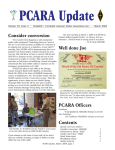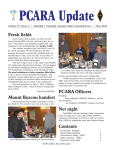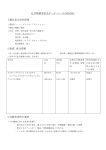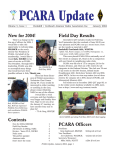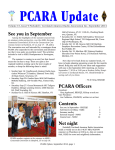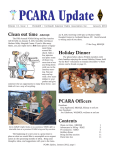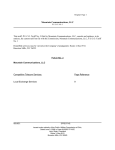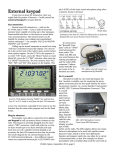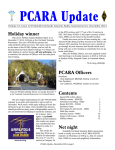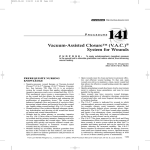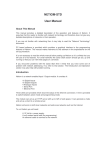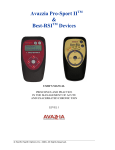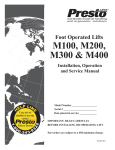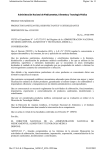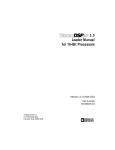Download PCARA Update September 2002
Transcript
PCARA Update Volume 3, Issue 9 Peekskill / Cortlandt Amateur Radio Association Inc. Remembrance and preparedness As we approach the first anniversary of one of the most tragic series of events in our country’s history, it is a time for resolute remembrance and reflection. Let us never forget. As amateur radio operators it is a time to evaluate what we have learned, and to determine if we are now better prepared to deal with such events than we were one year ago. We need to continue to be ready and to hone our skills. A way in which we can continue to be proactive is in the form of our Emergency and Disaster Response Team (EDRT). Over the next few weeks a Resource Manual as well as a preliminary Response Plan will be drafted. From our membership we will need a listing of any equipment that would be available for use by the association in the event of an emergency or disaster in our service area, as well as contact information. This will be covered in more detail at September’s meeting. To all of the members who have made generous contributions toward the 2m repeater upgrade project, a very big thank you! We still have a long way to go. If you haven’t made a contribution yet, please consider doing so. The upgrade will substantially improve our ability to provide services in our region. I hope to see each and every one of you at the September meeting. — 73 de Greg, KB2CQE Repeater Fund September 2002 hard to imagine that cooler weather is around the corner after a full week of close to 100 degree days!). Below is equipment that has been donated by members and assembled for the new repeater project: 1- Motorola Micor 110W repeater consisting of unified chassis, PA, receiver and power supply – N2CBH. 2- Repeater Controller with voice recorder and remote base interface – NM9J. 3- Interconnecting harness supplies – N2CBH 4- Sinclair Cavity set, which has proved to be unsuitable – N2CBH. 5- Crystals: – N2CBH. PCARA currently has 55 members on its roster. The estimated cost to finalize this project sits at $2,000, which is needed to upgrade the repeater cavities. Two thousand divided by fifty five members equals $36.36 each, as a contribution to this project. Of course, this donation is strictly on a voluntary basis, and a Motorola Micor repeater being larger donation would transformed into the new PCARA help to offset those 2m repeater at N2CBH. who are unable to make a donation at this time. A special PCARA fund has been established to earmark the donations for the new repeater work. Any assistance you can provide would be most graciously accepted. Member contributions to the “Repeater Fund” will be recognized with a certificate of appreciation. Please send your donation to: PCARA (Repeater Fund), PO Box 32, Crompond, NY 10517. Donations so far have been received from Charles, WA2WGJ; Malcolm, NM9J; Ray, W2CH & Marylyn; Ed, WA2AXP; Karen, WA2CVU; Armen, N2PLZ and Sean, KC2IDN. As many of you know, PCARA, under the direction of Bob, N2CBH, with assistance from Malcolm, NM9J, is undergoing a major overhaul of our main 2-meter repeater (146.670 - W2NYW). This repeater receives the daily use of many members and has served us well, however this upgrade is needed in order to ensure the continued availability and reliability of this machine for our members and others. Major portions of the costs associated with this undertaking have come from the pockets of a couple of members. We’re now down to the final stretch and would like to have this project com— 73 de Greg, KB2CQE; Bob, N2CBH; Joe, KR2V. pleted prior to the settling in of cooler weather (it’s PCARA Update, September 2002, page 1 A CW treasure Keep your eyes open for one of these at a hamfest. Self contained, can be powered by a “DC Wall Wart”. Programable speeds from 1 to 100 wpm. Capacitive touch, not mechanical and much more! The SA-5010 µMatic Keyer is a compact unit with modern design in electronics and styling. The Memory Keyer uses a microprocessor which keeps component count low and reliability high. Features of the Memory Keyer include: 1. Up to ten buffers for storing text or commands. These are variable length buffers,which elimiAn oldie but goody — the nate wasted memory Heath SA-5010 µMatic Keyer space. Available [photo by WA2EWP] memory is also effectively increased by the use of “command strings” and by a repeat feature which which allows you to automatically send a message up to ten times. 2. An editing feature which allows easy recovery from errors when you load a message buffer. 3. A built-in sidetone oscillator and speaker with variable volume and pitch. A phone jack and earphone is provided for private use. 4. A thin 22-position keypad lets you select character formation, speed, character spacing, character weighting, message repeat count, buffer number and mode. The sidetone is gated to provide audible feedback to produce a click. Illegal entries and error conditions produce a “warble.” 5. Integral capacitive “touch” paddles which reduce fatigue. The paddles unplug and store inside the keyer when not in use. Also, a rear panel jack is provided for an external mechanical paddle assembly. 6. Full “iambic” features. 7. Five LEDs to indicate the current mode. 8. A practice mode which allows you to send random code groups of random length and selectable types(alpha, alphanumeric, and alphanumeric plus punctuation). 100 different repeatable random sequences are available, all of which are altered every time you turn off the keyer. 9. A (PC) key which allows you to pause, manually insert text into a buffer message being sent, and then continue.When you insert a pause character in a message or command string , an automatic pause is made at that point so you can manually insert text. 10. CMOS memory with battery backup to retain the buffer contents as well as the last selected speed, spacing, weight,and repeat count while the Keyer is turned off and unplugged. 11. Selection of either right-handed or left-handed operation from the keypad. 12. Built-in diagnostics that check the microprocessor each time the keyer is turned on, and test RAM when batteries are re-placed or when the Keyer is reset. 13. Automatic shutoff after more than approximately 15 minutes of non-use. 73 — •• • Don, WA2EWP Scratched display Do you have a piece of amateur radio equipment where the liquid crystal display has become scratched? Maybe the display is difficult to read now — scratches certainly spoil the look and they might reduce the resale value. Here’s a hint I discovered recently — you can take out light scratches in plastic faceplates Cadie Products’ Krazy Kloth with a product called Krazy Kloth®, available in the paper towel aisle of our Cortlandt Town Center A&P. Krazy Kloth is a cotton cloth impregnated with “super-activated chemicals”. Simply rub the scratched surface with Krazy Kloth for a few seconds then polish the surface clean with a paper towel. Scratches usually disappear completely. Take a look at the “before” and “after” pictures of a Radio Shack scanner with a scratched LCD display. Scratch on plastic scanner dial indicated by arrow (left) was largely removed by rubbing with Krazy Kloth (right). This technique also works for plastic watch faces, but you might want to be far more cautious with the ultrathin face of a computer LCD display. Krazy Kloth can be used for removing stains and for polishing copper, brass and steel. It is also recommended by Cadie for cleaning tools and auto chrome. — NM9J PCARA Update, September 2002, page 2 Why I packed away my wall warts – Joe Ellman, KR2V If you’re like most modern day hams, chances are you have a host of wall warts lying around your shack. A couple of days ago I counted no less than six, today I count just two, one each for the two different cell phones my wife and I have, and these may go as well. No, I haven’t given up on my many battery-powered devices, HT’s, cell phones, digital camera, etc. Nor have I found an alternate source of energy for these rechargeable battery gobblers. Instead, I purchased a device I long thought about, and after one day of use, I’m hooked and wish I had done this sooner. The device I’m referring to is the Maha MH-C777PLUS-II Universal Charger and Analyzer. This is one amazing charger that can handle Lithium Ion (3.6V to 14.4V), NiMH and NiCd (1.2V to 14.4V) battery packs, not only from HT’s, but also cell phones, Maha MH-C777PLUS-II universal charger and analyzer digital cameras, camcorders, etc., plus, with a special adapter, the unit will charge AA, AAA, C, and D rechargeable batteries. In addition to the recharge function, the MH-C777PLUS-II will analyze and condition your battery packs. The LCD display keeps you upto-date on what’s going on with the battery pack during the charge function, and includes the elapsed time, voltage, and capacity. There is a heat sensor that is placed on the battery while charging that will shut down the unit in the event the battery temperature reaches an unsafe level. Once a battery pack reaches its capacity, the MH-C777PLUS-II will automatically switch to a trickle/maintenance function, and the battery can be left on the unit and removed when it’s convenient for the user. Since no two HT’s and other devices seem to use the same battery, the MH-C777PLUS-II utilizes a floating pin system, which adjusts and is capable of handling what seems to be any size battery pack, within its specified range. A large internal magnet helps to hold different size packs in place. In addition to the AC power supply, a vehicle power adapter is included, which makes this a useful ARES/RACES piece of equipment. One final note, the user manual was clear and to the point, a well written document that was easy to understand, and allowed me to get my first battery on the charger in about five minutes. Speaking of time, the instruction manual for my Icom T7H dual band HT calls for a 15-hour charge for the 9.6V (650 mAH) NiCd battery pack included with the radio. Since Sean and I both have T7H’s, that’s 30 hours of battery charging. One hour for each T7H battery was all it took to reach full capacity on the C777Plus-II. For more information visit Maha’s web site at http://www.mahaenergy.com. — Joe, KR2V The hamfest habit PCARA members have been heading for the hamfests recently. August 11 saw several vehicles crossing the border at Port Jervis into Pennsylvania for the Tri-State Amateur Radio Association hamfest at Matamoras Airport Park. Entrance to the park is by driving down what used to be the main runway. Joe, KR2V organized a club table and various items were sold for the benefit of PCARA funds. Bright and early the following Saturday morning, members converged on Oakland, New Jersey for the Ramapo Mountain Amateur Radio Club hamfest. This was a somewhat larger event, with KJI Electronics selling the latest equipment from inside the air-conditioned American Legion Hall. Outside, in the hot sun, Joe organized another club table where several members successfully disposed of their older amateur radio equipment. Bob N2CBH, Sean KC2IDN, Gary WB2HNA and Joe KR2V man the PCARA club table at the Ramapo Mountain ARC Ham Radio and Computer flea market. PCARA Update, September 2002, page 3 Listen to me! Watch this! — Karl N2KZ Let me introduce you to some of my best friends. All of them love DXing but they almost never transmit. These are people who just love to listen and have developed expert skills and home-brew equipment and modifications to eek out the last dB. Many of them have never been amateur radio operators, nor do they want to be. It’s a world you should know and learn from. If you start at the very bottom, you’ll discover the Long Wave Club of America. This is a diverse group of experimenters and DXers, ranging from advanced hams to engineers to geologists. Some members listen to the natural sounds of the earth at frequencies down as low as just a few kilohertz. Others experiment with two-way communications or operating beacons in the license-free 160 to 190 kHz band. Many try to log TWEB – transcribed weather broadcast stations, aeronautical and marine beacons, and even broadcast stations still operating on long wave in Europe and beyond. Beacon stations provide an easy way to practice Morse code at very slow speeds. These stations do nothing but identify themselves by repeating two or three Morse letters over and over again. One of the most famous beacons is TUK in Nantucket off Cape Cod. Antenna and ground design is in the forefront here. Serious experimenters design and install enormous loading coils and complex and elaborate ground systems to make their own beacon transmitters successful. When you’re on the receiving end, great lengths are taken to null out noise, probably the biggest challenge in this range. Many LW DXers use amplified loop antennas to provide gain and tight nulls away from noise. In some cases, experimenters even skew several loops to provide very selective gain in a precise direction. Ground wave propagation and conductivity rule here. This a fascinating group taking on great engineering challenges. Refer to their web site http:// www.lwca.org for more information. Remember Field Day? There were pile-ups of several stations per frequency all trying to rapidly exchange information and identifying every 30 seconds or so. If you think this is chaos, you should try being a Medium Wave DXer. On Field Day, the strongest station may be as much as 1,000 watts. Try to imagine what it would be like if there were dozens or even hundreds of stations, all transmitting with incredibly compressed audio, on the same frequency, all at once with up to 50,000 watts. Even worse, some of them barely identify once an hour. This is the challenge of Broadcast Band DXing, also known as good old AM radio. This hobby requires saintly patience and skill, yet all you need is a five-dollar radio to get started. People use mile-long Beverage antennas and arrays of phased long-wires and loops to simple ferrite loops. You learn quickly how to null out powerful signals to reveal the ones beneath. Sunrise and sunset skip and the wee hours of the overnight all are important times to increase your totals. The Aurora Borealis and the full moon can create miraculous openings where all stations within 2000 miles are attenuated, yet you can be riding in your car listening to Mexico, Venezuela, The Caribbean or beyond. Seasoned DXers, like legendary Mark Connelly, WA1ION, in Billerica, MA near Boston routinely logs medium wave stations from Europe, The Middle East and Africa. His West Coast counterpart, Patrick Martin, pulls in India, Indonesia and beyond trying to dodge those annoying pest stations from Australia and Japan, all on good old AM. The best broadcast band (BCB) DXers have thousands of stations in their logs. There are two domestic clubs that embrace medium wave: the International Radio Club of America and the National Radio Club. Both offer endlessly interesting books and reprints of technical articles that are quite applicable to low band amateurs who enjoy 160, 80 and 40 meters. I highly recommend the IRCA. I am a former President! Look for medium wave broadcast AM DX action at http://www.ircaonline.org/index.html - and - http:// www.nrcdxas.org. If the world of six meters and above is your pleasure, you’ll enjoy what the Worldwide TV-FM DX Association has to offer. Several hundred DXers exchange loggings and technical information regarding a variety of experiments involving, primarily, complex antenna arrays and phasing systems. Yes, Martha, these guys still use TV antennas daily and swear by them! Last year, when conditions were especially good, many members enjoyed watching wildly fading F2 skip on their televisions from South America and as far away as Australia and New Zealand. FM reception can take you thousands of miles away via E-skip, aurora or meteor bursts. This group keeps up with the times. There is a growing faction that now DXes the new digital TV broadcasts that are now coming on the air. There are some very interesting tricks to identifying TV PCARA Update, September 2002, page 4 stations, like positive and negative offsets of video frequency, distinct characteristics of the station’s vertical interval, or even hidden levels of closed captioning, data, or other auxillary information. Learn how to hear what piggybacks on TV signals: exact time correction, SAP and PRO audio, even stock and sports information. FM signals have similar attributes. Especially interesting is the recent incorporation of the BBC’s RDS radio data service system, which can provide you with an instant station ID if you are equipped to decode it. You can also enjoy a variety of broadcasts that are transmitted on FM stations’ subcarriers. Muzak background music and services for the blind and select ethnic groups are available if you know where and how to look for them. There is a faction of the WTFDA that DXes NOAA weather radio stations on 162 MHz. Don’t laugh. These stations make wonderful propagation beacons. For example, WWH26 on 162.425 MHz in Newport, NC is an excellent indicator of long distance tropo into the Carolinas. It is the only NOAA station on 162.425 along the Atlantic Coast. When it breaks your squelch, head for 2 meters, 220 and 440 MHz for great fun. Read all about it at http://www.anarc.org/wtfda/. All of these clubs have frequent newsletters and Internet reflectors to keep their membership up-to-the-minute. Each club produces extensive guidebooks for each of these band segments to help you identify your catches and help you plot your strategy. If you are looking for new aspects to our hobby, this may be your ticket. Listen carefully. You might really like it! — 73 de N2KZ Karl Editor’s note Your editor is not going to let Karl’s line about “broadcast stations still operating on long wave in Europe and beyond” go by without an explanation and a comment. Over on the other side of the pond in Europe and in the ex-Soviet Union, long wave broadcasting is still alive, stretching back in time almost as far as what is called AM broadcasting on this side of the Atlantic. Traditional European broadcast radios did not have an “AM” button, instead they had two buttons marked “MW” for medium wave and “LW” for long wave. If your radio was likely to be used in a French speaking country it might also be marked with “PO/GO”, which has nothing to do with jumping sticks. The advantage of long wave broadcasting is that the coverage area is much greater than for medium frequencies. In the UK, the BBC’s main long wave transmitter at Droitwich in the English Midlands runs 500 kilowatts on 198 kHz and covers most of England, day and night. For comparison, BBC Radio 5 Live uses six main transmitters rated from 10 to 200 kilowatts, to cover roughly the same area on two separate medium frequencies of 693 and 909 kHz. The downside of long wave is that electrical noise can be more disruptive — especially near TV sets or industrial locations — and nowadays, with most radios being manufactured in the Far East it is getting increasingly difficult to purchase an everyday set with a “long wave” button. However, if you take a look at Radio Shack’s DX-398 and DX-402 worldband radios, you will find a “LW” button just waiting to be pressed. — Malcolm, NM9J Mobile mount The photo shows PCARA member Charlie, WA2WGJ, mounted on a camel while on vacation during June 2002. Charlie reports that he wore his DXCC pin throughout the visit to Portugal, Spain and Morocco, but did not run into any other radio amateurs. PCARA Officers President: Greg Appleyard, KB2CQE Vice President: Bob Tarsio, N2CBH Secretary/Treasurer: Joe Ellman, KR2V PCARA Update, September 2002, page 5 [email protected] [email protected] [email protected] Peekskill / Cortlandt Amateur Radio Association Information/Fax line: 914 737-0348 E-Mail: [email protected] Web site: http://www.pcara.org PCARA Update Editor: Malcolm Pritchard, NM9J E-mail: [email protected] Newsletter contributions are always very welcome! PCARA Information PCARA is a Non-Profit Community Service Organization. PCARA meetings take place the first Sunday of each month at 3:00 p.m. in Dining Room B of the Hudson Valley Hospital Center, Route 202, Cortlandt Manor, NY 10567. Drive round behind the main hospital building and enter from the rear (look for the oxygen tanks). Talk-in is available on the 146.67 repeater. PCARA Repeaters W2NYW: 146.67 MHz -0.6, PL 156.7Hz KB2CQE: 449.925MHz -5.0, PL 179.9Hz N2CBH: 448.725MHz -5.0, PL 107.2Hz PCARA Calendar Sun Sep 8: September meeting, 3:00 P.M., HVHC. Presentation by SATERN. Sun Oct 6: October meeting, 3:00 P.M. HVHC. Visit from ARRL Hudson Division Director, Frank Fallon, N2FF. Hamfests Sat Sept 7: Saratoga County RACES, Saratoga Cnty Fairgrounds, Ballston Spa, NY. 7:00 A.M. Sun Sept 15: LIMARC Hamfest, Briarcliffe College, 1055 Stewart Ave., Bethpage, NY. 8:30 A.M. Sun Sep 22: Candlewood ARA, Edmond Town Hall, Rt 6, Newtown CT., 9:00 A.M. Sat Oct 12: Bergen ARA Hamfest, Westwood High School, 701 Ridgewood Rd., Washington Twnship NJ., 8:00 A.M. VE Test Sessions Sep 1, Oct 6: Yonkers ARC, Yonkers Police Dept., 1st Precinct, East Grassy Sprain Rd, 9:00 A.M. Contact: Daniel Calabrese, 914 667-0587. Sep 9: Split Rock ARA, Hopatcong HS, Hopatcong NJ. 7:00 P.M. Contact Sid Markowitz, 973 724-2378. Sep 10: Crystal Radio Club, Rockland Co Fire Trg Ctr, Firemans Memorial Drv, Pomona NY, 7:00 P.M., contact Robert Chamberlain 845 354-7340. Sep 20: Bergen ARA & Fair Lawn RC, Fair Lawn Cultural Center, 12-56 River Rd., Fair Lawn, NJ. 7:30 p.m. Contact D C Younger, 201 265-6583. Sep 23: Columbia Univ ARC, Watson Labs, 612 W 115th St. New York, NY 10025, 6:30 P.M. Contact Alan Crosswell, 212 854-3754. Sep 28: Putnam Emergency ARL (PEARL), EOC, Putnam Co Office Bldg, Carmel, NY. 9:00 a.m. Contact NM9J, 736-0368. Peekskill / Cortlandt Amateur Radio Association Inc. PO Box 32 Crompond, NY 10517 PCARA Update, September 2002, page 6







